
* In the spring of 1945, a French aircraft designer and resistance fighter named Marcel Bloch, who had been imprisoned in the Buchenwald concentration camp in Germany, returned to France. There he changed his name to Marcel "Dassault", which had been his brother's "nom de guerre" in the French underground, and within a year established an aircraft manufacturing firm, the "Societe des Avions Marcel Dassault". From then on, the name "Dassault" would become a trademark of a series of French combat and civil aircraft. This document details the evolution of the first major series of aircraft produced by Dassault, the "Ouragan". "Mystere", and "Super Mystere".
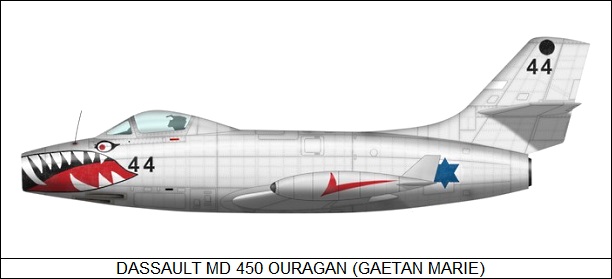
* Although the French, as citizens of an occupied country, were not able to contribute significantly to the great strides made in aircraft design made during World War II, after the war Marcel Dassault saw no reason why the French could not jump back into the race. In 1947, he outlined ideas for a jet fighter. French government response to his fighter was positive but did not result in a development contract, and so Dassault decided to proceed on his own.
Detailed design work on the new aircraft, which was given the designation "MD (Marcel Dassault) 450", began in December 1947, with construction beginning in April 1948. A French government contract for three prototypes followed in June, and the initial MD 450 "Ouragan (Hurricane)" fighter flew at the end of February 1949. The prototype lacked cockpit pressurization and armament.
The Ouragan was inspired by American designs, and had a general configuration like that of the Republic F-84 Thunderjet: essentially a "stovepipe" with intake in the nose, low-mounted straight wing, bubble canopy, and tricycle landing gear; all the landing gear assemblies had single wheels, with the nosewheel retracting forward and the main gear hinging in the wings to retract towards the fuselage. The Ouragan was smaller than the Thunderjet, however, weighing about a tonne less, and featured a thin wing much like that of the Lockheed F-80 Shooting Star, as well as a swept-back tailplane. The prototype Ouragan was powered by a Rolls-Royce Nene 102 centrifugal-flow turbojet, license-built by Hispano-Suiza, with about 22.27 kN (2,270 kgp / 5,000 lbf) thrust.
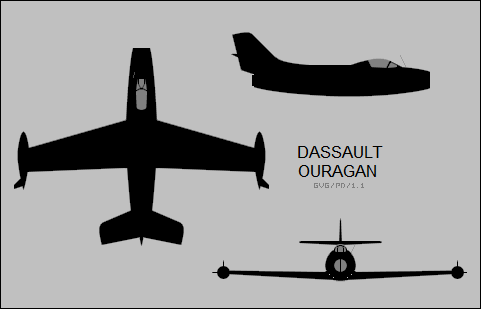
After delivery of the third prototype, the French government followed up with a order for 15 pre-production prototypes, though only 12 were actually built. They would eventually be used to evaluate different engines fits, as well as various weapons fits, such as rocket packs; reconnaissance payloads; and night-fighting radar -- more on this last item below.
In late August 1950, well before delivery of the pre-production machines, the French government had placed an order with Dassault for 150 full production Ouragans. The government had been talking about a buy of 850 machines and the actual order was a bit disappointing for Dassault, but it was still a sizeable order and nothing to complain about. In fact, the government would order 200 more Ouragans, and the firm would be strained to build them fast enough.
___________________________________________________________________
MD 450 OURAGAN:
___________________________________________________________________
wingspan:
13.16 meters (43 feet 2 inches)
wing area:
23.4 sq_meters (252 sq_feet)
length:
10.73 meters (35 feet 2 inches)
height:
4.14 meters (13 feet 7 inches)
empty weight:
4,140 kilograms (9,130 pounds)
max loaded weight:
6,800 kilograms (15,000 pounds)
maximum speed:
940 KPH (585 MPH / 510 KT)
service ceiling:
14,900 meters (49,000 feet)
range:
965 kilometers (660 MI / 575 NMI)
___________________________________________________________________
* The first operational Ouragans were delivered in 1952, replacing the De Havilland Vampire in French service. The first 50 Ouragans were built as "MD 450As" with the Nene 102 engine; the rest were "MD 450Bs", fitted with a Hispano-Suiza-built Nene 104B engine, which was lighter than the Nene 102 and had slightly greater thrust. Wingtip fuel tanks were fitted as standard in both cases. The Ouragan was armed with four Hispano Mark V 20-millimeter cannon beneath the engine intake, and could carry up to a tonne (2,200 pounds) of stores under the wings. Typical stores included two 450-kilogram (1,000-pound) bombs; 16 105-millimeter (4-inch) Matra T-10 rockets; or 8 rockets and two 460-liter (121 US gallon) napalm bombs.
Armee de l'Air (AA) pilots found the Ouragan very pleasant to fly. It was a very stable gun and rocket firing platform -- though it did have a tendency to snap into a flat spin in tight turns, because of its stubby fuselage. The Ouragan was the demonstration aircraft for the "Patrouille de France" aerobatic team for two years.
Several production Ouragans were modified for rough field operation, with the single-wheel main gear changed to a two-wheel configuration fitted with low pressure tires, each assembly retracting into a fairing added under the wing roots. These aircraft were also fitted with brake parachutes. This configuration was intended for operations in the war in Algeria, and aircraft so fitted were nicknamed "Barougans", from the Arabic word "baroud (battle)". However, nothing came of the project, and some of the test machines were reconverted back to standard Ouragan configuration.
* The Ouragan did not have a long first-line service life with the AA, being phased out in favor of the much-improved Dassault Mystere IVA -- more below -- beginning in the spring of 1955. Ouragans would persist in French service into the early 1960s as advanced trainers.
They would fly much longer in foreign service. In 1953, India ordered 71 Ouragans with the slightly uprated Nene 105 engine, with most of the order delivered that year. Additional orders from India brought the total to 104, though only the first 71 were new-build aircraft, with the remainder passed on from AA service. The Indians named the aircraft the "Toofani", the Hindi word for "Hurricane". As with the AA, the Ouragan was quickly phased out of first-line service by the Dassault Mystere IVA, beginning in 1958, but the older aircraft would continue to be used as advanced trainers. The Indian Air Force apparently used the Ouragan in domestic counter-insurgency operations, but records are sketchy.
The Israeli Air Force (IAF) was an enthusiastic Ouragan user. In 1955, the Egyptian government signed an agreement with Czechoslovakia to buy advanced Russian arms, such as the MiG-15 fighter. The only jet fighter the IAF possessed was the Gloster Meteor, which was no match for the MiG-15, and the Israelis quickly moved to upgrade their force. The Israelis ordered 24 Dassault Mystere IICs, discussed below, and 24 Canadair Sabre Mark 6 fighters, but the Mystere IIC was found to suffer from structural problems, and the Canadians decided not to supply the Sabres lest they inflame Middle Eastern instability. The Israelis opted to buy the better Mystere IVA, but since it was not in production at the time, they ordered the Ouragan as a stopgap.
The IAF bought an estimated 75 Ouragans, with at least 12 of these being new-build aircraft, and the rest passed on from AA service. First deliveries were in 1955, just in time for Operation MUSKETEER, the 1956 Anglo-French-Israeli invasion of Egypt to seize the Suez Canal. The Israeli Ouragans were assigned to close support operations, since they could not match the performance of Egyptian MiG-15s. The Ouragan proved excellent in this role, being reliable and tough. Despite the fact that it wasn't assigned air combat missions, Egyptian pilots were poorly trained and Israeli pilots, flying Ouragans sometimes sporting lurid sharkmouth markings, took on Egyptian pilots with success. A senior IAF official later said: "The Ouragan was a much better aeroplane than had been thought."
Ouragans were relegated to advanced training as better aircraft became predominant in Israeli service, but the type saw more combat in the 1967 Six-Day War. In 1975, the Israelis sold 18 of their Ouragans to El Salvador, where they remained in service until the late 1980s, sporting jungle disruptive camouflage colors.
BACK_TO_TOP* Even before the Ouragan was delivered to the AA, Dassault was working on a more advanced machine based on it, which would take to the air in early 1951 as the "MD 452 Mystere (Mystery) I". The first prototype Mystere I was essentially an Ouragan with a 30-degree swept wing and modified tail surfaces. Two further prototypes followed, powered by the Rolls-Royce Tay 250 centrifugal-flow turbojet, an improved version of the Nene, built under license by Hispano-Suiza, and rated at 28.0 kN (2,850 kgp / 6,280 lbf) thrust.
These three Mystere I prototypes led to two "Mystere IIA" prototypes, powered by the Tay and armed with four Hispano 20-millimeter cannon; and then four "Mystere IIB" prototypes, which traded the four 20-millimeter cannon for two 30-millimeter DEFA revolver-type cannon. A Mystere IIA was the first French aircraft to break Mach 1 in controlled flight (in a dive) on 28 October 1951.
The eleven pre-production machines that followed were designated "Mystere IIC", nine of which were fitted with the SNECMA Atar 101C axial-flow turbojet, rated at 24.5 kN (2,500 kgp / 5,510 lbf) thrust, while two were experimentally fitted with the afterburning Atar 101F, with afterburning thrust of 37.3 kN (3,800 kgp / 8,380 lbf).
___________________________________________________________________
MD 452 MYSTERE IIC:
___________________________________________________________________
wingspan:
13.1 meters (42 feet 9 inches)
wing area:
30.3 sq_meters (326 sq_feet)
length:
11.7 meters (38 feet 6 inches)
height:
4.26 meters (14 feet)
empty weight:
5,225 kilograms (11,495 pounds)
max loaded weight:
7,475 kilograms (16,480 pounds)
maximum speed:
1,060 KPH (660 MPH / 575 KT)
service ceiling:
15,250 meters (50,000 feet)
range:
885 kilometers (550 MI / 480 NMI)
___________________________________________________________________
The AA ordered 150 Mystere IICs, with the first production machine flying in June 1954 and delivered in October of that year. The production aircraft featured twin 30-millimeter DEFA cannon, an Atar 101D turbojet with 29.4 kN (3,000 kgp / 6,615 lbf) thrust, increased tail sweep, plus revised intake trunking and internal fuel tank arrangement. Details of external stores are unclear, but a reasonable assumption would be that they were similar to those of Ouragan.
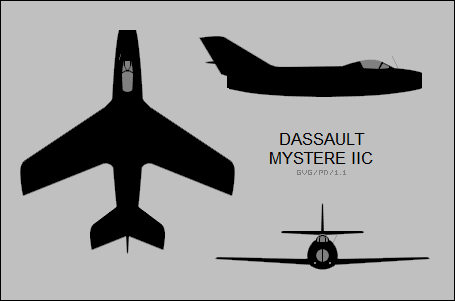
The last Mystere IIC was delivered in 1957, by which time the type was already being relegated to advanced training duties. Aircraft design was moving at a breakneck pace in the 1950s; even as the Mystere IIC was becoming operational, the better Mystere IVA was flying. The Mystere IIC was very much an interim type, though it did persist in the training role until 1963. There were no foreign buyers of the Mystere IIC. As noted, the Israelis wanted to buy 24, but changed their minds and bought Mystere IVAs instead. Sources give no hint that the Mystere IIC was ever used in combat.
* There was only a single "Mystere III", or more precisely "Mystere IIIN", derived from experiments with the Ouragan. One of the original Ouragan prototypes had been built as a demonstrator for a night fighter, with a solid nose containing air intercept radar and the air intakes moved to the side of the aircraft, under the cockpit. It was fitted with twin 30-millimeter DEFA cannon and designated "MD 350-30-L", with the "30" meaning the 30-millimeter guns and the "L" meaning the lateral intakes.
The modified Ouragan retained its single-seat configuration. It was intended to lead to a two-seat night fighter, the "MD 451", but the development of the Mystere II made it more attractive to develop a two-seat version of the Mystere II instead.
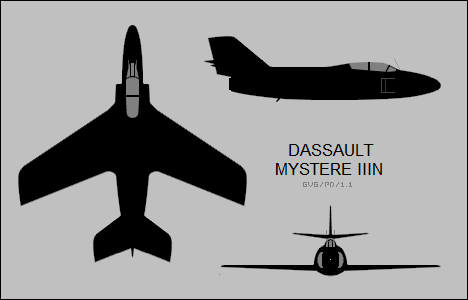
The result was the "MD 453 Mystere IIIN", or "Mystere de Nuit". This aircraft had the solid nose and lateral intakes of the Ouragan night fighter variant, and was powered by the Tay. It first flew in July 1952. Two more prototypes were planned, but they were never built since interest had moved on to a night fighter version of the Mystere IV. The sole Mystere IIIN was never fitted with radar and the program was abandoned in December 1953. However, the aircraft was later used for ejection seat trials.
BACK_TO_TOP* The "Mystere IV" was essentially a new design, a "clean sheet" rethinking of the Mystere II, not just a modification of it. The first prototype was flown in September 1952; it was powered by a Hispano-built Rolls-Royce Tay 250 turbojet, as were the early Mystere IIA prototypes.
While the Mystere IV also featured the twin 30-millimeter DEFA cannon adopted for the Mystere II, the Mystere IV had a new and more robust oval-section fuselage, a thinner wing with greater sweep, and new tail surfaces. The result resembled the Mystere IIC in a general way but had cleaner lines, more in the class of the US F-86 Sabre.
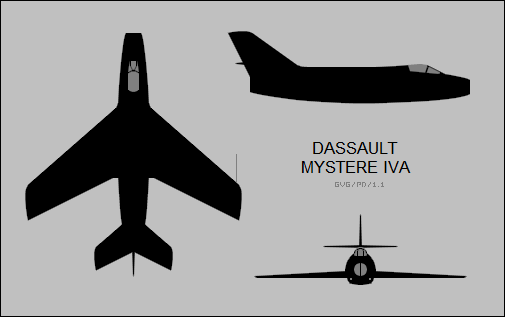
There was apparently only one prototype, leading to a production contract for 225 Mystere IVAs for the AA. Interestingly enough, this batch of aircraft was purchased for the French by the United States as part of the NATO Military Assistance Program, though the French would purchase 100 more Mystere IVAs with their own funds. The first production Mystere IVA flew in late May 1954, and the type entered service with the AA the next year, being initially deployed as an interceptor. It would also be used as ground-attack fighter in French service. The first 50 production aircraft used the Tay 250 engine, but all following production was fitted with an uprated Tay, the Hispano-built Verdon 350, with 34.3 kN (3,500 kgp / 7,715 lbf) thrust.
___________________________________________________________________
MYSTERE IVA:
___________________________________________________________________
wingspan:
11.12 meters (36 feet 6 inches)
wing area:
32 sq_meters (344.5 sq_feet)
length:
12.85 meters (42 feet 1 inch)
height:
4.59 meters (15 feet 1 inch)
empty weight:
5,870 kilograms (12,950 pounds)
max loaded weight:
9,500 kilograms (20,950 pounds)
maximum speed:
1,120 KPH (695 MPH / 605 KT)
service ceiling:
15,000 meters (49,200 feet)
range:
920 kilometers (570 MI / 495 NMI)
___________________________________________________________________
The Mystere IVA had four stores pylons, with a total load capacity of 900 kilograms (2,000 pounds). It appears that in typical flight configurations two of the pylons were fitted with drop tanks, while two others carried bombs or Matra 68-millimeter unguided rocket packs. As with many early jet aircraft, the Mystere IVA's range without drop tanks was pathetic.
The Mystere IVA served for a time as the mount for the Patrouille de France. It remained in first-line service with the AA until the early 1960s, when it was replaced by the Mach 2 Dassault Mirage IIIC delta-winged fighter. The Mystere IVA remained in service in the ground-attack role until 1975, when replaced by the SEPECAT Jaguar, and as an operational trainer until 1980, when it was replaced by the Dassault-Dornier Alpha Jet.
60 of the Verdon-powered Mystere IVAs that were ordered by the French ended up being sold to Israel, with the first batch of 24 arriving April 1956, just in time for Operation MUSKETEER in October. In the hands of skilled IAF pilots, they proved themselves more than a match for Egyptian MiG-15s. French Mystere IVAs also participated in the October 1956 war, operating from Israeli bases with an Israeli squadron number, and French pilots would also fly some of the Israeli Mystere IVAs during that war. The remaining 36 Mystere IVs in the batch were shipped to Israel after the 1956 war. Two squadrons of Mystere IVAs were still in Israeli service in the Six-Day War in 1967.
The Indian Air Force also bought 110 Verdon-powered Mystere IVAs; these were all new-production aircraft. First delivery was in 1957. The type was used in the close-support role during the 1965 Indo-Pakistan war; like its ancestor, the Ouragan, it proved reliable and able to absorb punishment.
* The Mystere series continued to evolve, with an improved "Mystere IVB" developed to take advantage of the new afterburning engines. The Mystere IVB was almost a new aircraft, with a new fuselage and redesigned tailfin, and also featured a radar gunsight similar to that used on the F-86 in the upper lip of the intake.
The first prototype flew in December 1953. It was powered by an afterburning Rolls-Royce Avon RA.7R axial-flow turbojet, with a maximum afterburning thrust of 42.5 kN (4,330 kgp / 9,550 lbf). Another Avon-powered prototype flew in June 1954, while a third prototype, powered by the Atar 101F (which, as mentioned, was fitted experimentally to two pre-production Mystere IICs), flew in March 1955.
Seven pre-production Mirage IVB aircraft were also completed. The first two were fitted with a SEPR 66 rocket motor to provide boost thrust, and the last two were powered by the afterburning Atar 101G-2 turbojet with 44.1 kN (4,500 kgp / 9,920 lbf) afterburning thrust. The Mystere IVB was promising, but Dassault was already working on an even better aircraft, the Super Mystere, and so the Mystere IVB did not enter production.
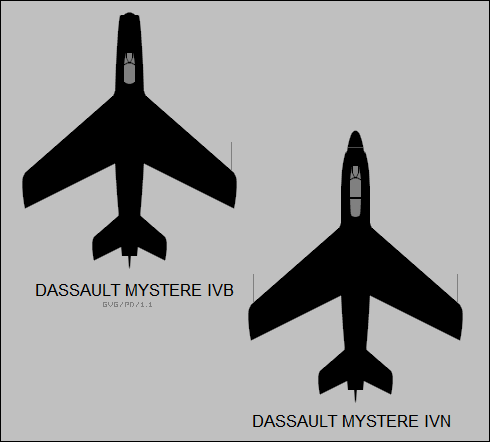
* As mentioned above, a single night-fighter version of the Mystere IVB, the "Mystere IVN", was completed and flew in 1954. The prototype was powered by an Avon RA.7R turbojet, and was stretched 1.4 meters (4 feet 7 inches) to accommodate two tandem seats plus additional fuel. It was to be fitted with US-built AN/APG-33 air-intercept radar in a nose radome above the intake, giving it a certain resemblance to the US F-86D "Sabre Dog" interceptor.
The Mystere IVN was armed with two 30-millimeter DEFA cannon, and like the F-86D had a retractable tray for unguided air-to-air rockets, in this case accommodating 55 Matra 68-millimeter rockets. Some sources claim that this tray was optionally fitted to the standard Mystere IVA, but if so it appears to have been little used. The project went nowhere because of problems with the radar and the limited endurance of the aircraft. The French were also developing another night fighter that seemed more promising, the twin-engine "Sud-Ouest Vautour IIN", and the Mystere IVN was canceled.
BACK_TO_TOP* The last of the Ouragan-Mystere series was the "Super Mystere", which was again largely a new aircraft, with a slight resemblance to the US F-100 Super Sabre -- flown by the AA, incidentally -- and similar in many ways, though smaller. It was the first "transonic" aircraft of European origin to reach quantity production.
The first prototype, the "Super Mystere B1", flew in March 1955. This initial prototype was powered by the Avon RA.7R engine, and featured wings with a 45-degree sweepback, as well as an updated cockpit plus a Super Sabre-like oval engine intake. The prototype broke Mach 1 in level flight the day after it first took to the air.
Five pre-production "Super Mystere B2s" followed, powered by the SNECMA Atar 101G, with the first of the five flying in May 1956. They led to the initial flight of the first production Super Mystere B2 in late February 1957. The production version was powered by improved Atar 101G-2 or G-3 engines, providing 33.1 kN (3,375 kgp / 7,400 lbf) maximum dry thrust, and 43.75 kN (4,460 kgp / 9,833 lbf) afterburning thrust.
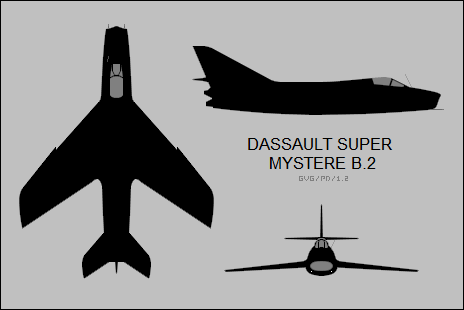
Armament consisted of twin DEFA 30-millimeter cannon. Early versions also had a rocket pack for 35 Matra 68-millimeter unguided rockets, but the rocket pack was quickly abandoned. The aircraft had two stores pylons, and could carry an external load of 900 kilograms (2,000 pounds), including drop tanks, bombs, unguided rocket pods, AS-30 radio-guided air-to-surface missiles, or Sidewinder heat-seeking air-to-air missiles.
___________________________________________________________________
SUPER MYSTERE B2:
___________________________________________________________________
wingspan:
10.5 meters (34 feet 6 inches)
wing area:
35 sq_meters (377 sq_feet)
length:
14.04 meters (46 feet 1 inch)
height:
4.53 meters (14 feet 11 inches)
empty weight:
6,985 kilograms (15,400 pounds)
maximum loaded weight:
10,000 kilograms (22,050 pounds)
maximum speed:
1,200 KPH (745 MPH / 650 KT)
service ceiling:
17,000 meters (55,750 feet)
range:
870 kilometers (540 MI / 470 NMI)
___________________________________________________________________
180 Super Mystere B2s were built for the AA, with the last delivered in 1959. They were relegated to the attack role after the Mirage III came on line, but remained in French service until the fall of 1977, being replaced by the Mirage IIC and Mirage F1C.
In 1958, two examples were completed with Atar 9B engines with 58.9 kN (6,000 kgp / 13,225 lbf) afterburning thrust. These machines were designated "Super Mystere B4". The type did not enter production, since by that time the much more advanced Mirage III was already entering service.
* 36 of the Super Mystere B2s bought by the French ended up being sold to the Israelis in 1958. The IAF was fond of the aircraft and nicknamed it "Sambad", after its initials ("SMB-Deux"). Israeli pilots found it a match for transonic Arab MiG-19s, and the Sambad generally came out the winner in the intermittent air skirmishes that took place between outright war.
The Sambad served in the ground attack role in the 1967 Six-Day War and the 1973 Yom Kippur / Ramadan War. In the early 1970s, the Israelis upgraded their surviving Super Mysteres by retrofitting them with a non-afterburning Pratt & Whitney J52-P8A turbojet, rated at 41.4 kN (4,220 kgp / 9,300 lbf) thrust, also used in Israeli Douglas A-4 Skyhawk attack aircraft. Fitting the J-52 required airframe modifications, resulting in a longer fuselage. Updated Israeli avionics were also fitted, and the variety and weight of external stores were increased as well.
The first example of the upgrade appeared in May 1973 and participated in the Yom Kippur / Ramadan War. In 1977, 12 of these uprated Super Mysteres were sold to Honduras, with the Hondurans operating the type until 1989, making them the last of the operational Ouragan and Mystere series.
BACK_TO_TOP* The Ouragan and Mystere series of fighters, though reasonably successful aircraft, are somewhat obscure and hard to find information on, so many details in this document remain uncertain. They defined a line of French fighter evolution that would lead indirectly to the entirely successful Mirage delta-winged fighter series, but ended up being overshadowed by the Mirage in the literature.
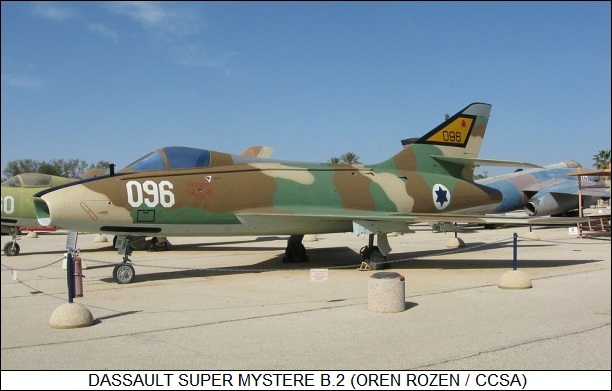
* Sources include:
* Revision history:
v1.0 / 01 oct 98 v1.1 / 01 may 01 / Review & polish. v1.2.0 / 01 may 03 / General rewrite. v1.2.1 / 01 may 05 / Review & polish. v1.2.2 / 01 apr 07 / Review & polish. v1.2.3 / 01 apr 09 / Review & polish. v1.2.4 / 01 oct 10 / Review & polish. v1.2.5 / 01 sep 12 / Review & polish, updated photos. v1.2.6 / 01 aug 14 / Review & polish. v1.2.7 / 01 jul 16 / Review & polish. v1.2.8 / 01 jun 18 / Review & polish. v1.2.9 / 01 apr 20 / Review & polish. v1.3.0 / 01 feb 22 / Review & polish. v1.3.1 / 01 jan 24 / Review & polish.BACK_TO_TOP
